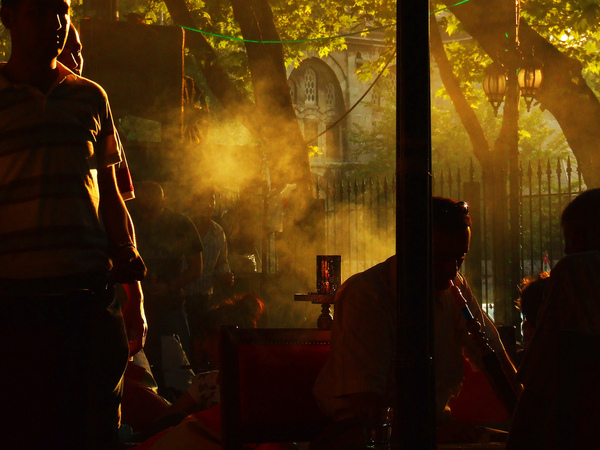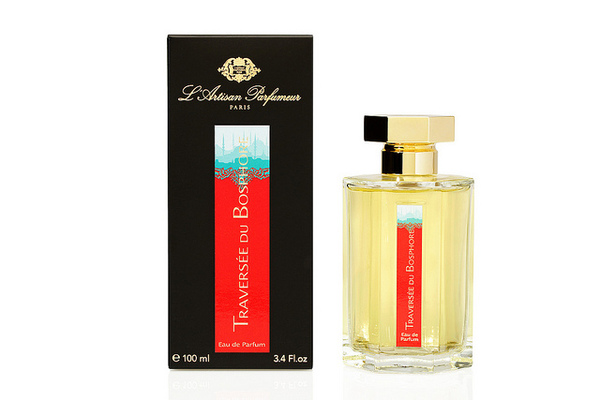L'Artisan Parfumeur Traversée du Bosphore (2010): Aquarelle of a Sheer Iris-Leather Oriental or an Anatomy of Luxury & Appearances {Fragrance Review}
Starting with the pulling-off of the cap - I instinctively tend to smell closed perfume bottles when taking off the cap even if it is a spray bottle to get a sneak peak of the contents and insights into potentially indiscreet, volatile notes - Traversée du Bosphore lets out a distinctive, coquettish powdery rose-violet accord which conjures up KenzoFlower but also lets through more Oriental notes in the background:..
...a round, golden, almost syrupy amber, a note of rose water, one of loukhoum and some leather and cardamom.
It feels fresh despite all this.
Official notes: Apple, pomegranate, tulip, iris, leather, saffron, Turkish delight accord (rose and pistacchio), vanilla, musks. ![]() The fragrance when you spray it onto the skin reveals a startingly fresh, doughy and uncooked note of iris underlined by a tiny hint of fruity berries. It soon moves into an iris-leather accord, which in and of itself can only be seen as a classic pairing of a powdery-skin and of a sueded impression. But it will no doubt benefit from a rethink by perfumer Bertrand Duchaufour who is usually highly aware of the opportunity of creative challenges. By way of the leather-violet accord popularized by Grey Flannel by Geofrrey Beene then Fahrenheit by Dior and more recently taken up again by perfumer Olivier Polge for Dior Homme as a leather-iris accord - a fragrance not coincidentally much admired by nose Bertrand Duchaufour who said it is a scent he would have liked to compose himself - we find a partial tradition bottled in Traversée du Bosphore and only perceptible as such to the nose in the drydown.
The fragrance when you spray it onto the skin reveals a startingly fresh, doughy and uncooked note of iris underlined by a tiny hint of fruity berries. It soon moves into an iris-leather accord, which in and of itself can only be seen as a classic pairing of a powdery-skin and of a sueded impression. But it will no doubt benefit from a rethink by perfumer Bertrand Duchaufour who is usually highly aware of the opportunity of creative challenges. By way of the leather-violet accord popularized by Grey Flannel by Geofrrey Beene then Fahrenheit by Dior and more recently taken up again by perfumer Olivier Polge for Dior Homme as a leather-iris accord - a fragrance not coincidentally much admired by nose Bertrand Duchaufour who said it is a scent he would have liked to compose himself - we find a partial tradition bottled in Traversée du Bosphore and only perceptible as such to the nose in the drydown.
I want to say that the iris-root note here is not just dewy or misty or even aquatic but more in the vicinity of "hydropic" as the flower seems to have been cultivated in the water rather than in the soil and thus to have drunk in all of the humidity available within a short radius.
It reminds me of a similar treatment, i.e., this idea of a gourmand-and-watery contrast of the iris note as found in Iris Ganache by Guerlain signed by perfumer Thierry Wasser (the name of the perfumer means "water" in German incidentally), which seems also to be too exaggerately drenched in water to be able to blame its state only on an occasional down pour à la Guerlain Après L'Ondée.
The iris-leather accord in Traversée du Bosphore weaves its gentle and even whispery path together with soft almond and sweet gourmand inflections of rose-water-scented lokhoums studded with the creaminess of green pistachios, further sweetened by the flavor of a light vanilla. The saffron helps create a salty-sweet dessert-y English-custard nuance. The verdant bite of green violet leaves, which probably contribute to the "tulip" accord, provides contrast while accenting the water-based theme. All this comes seemingly wrapped up as a hosptality gift in a slim raw-hide skin smelling of an Anatolian saddlery with accents of cured leather and sprinkled with finely powdered confectioner's sugar. There are some candied, floral gardenia-to-banana-like range of nuances, which then move into more oriental oud-like territory.
Traversée du Bosphore's personality turns out to be that of a particularly sheer gourmand oriental iris-leather composition.
While one could have felt tempted to classify it as a soft oriental, it is really much more characteristically a sheer, wan oriental composition where water and transparency are key effects predominating over mellowness and a sense of cosy, cushion-y comfort. Here the oriental fragrance is turned into a deliquescent version of its own self.
The iris note which is dominant in the scent and contributes essentially to this fragile aspect, is an exercise in capturing both the doughy, bread-like facet of iris root and a more impressionist attempt at making the note convey a sense of watery drifting. It is not surprising that the perfumer wanted to give water a central role to play in this evocation of Istanbul as water is omnipresent in the city with the sea hemming the sky all around the hills. There is no hint of seaside wateriness though; it is about a symbolic representaiton of the element water more than anything else. Perhaps, at most, it is a meditation on the rain drizzling on a glass pane in a çayhane and the blurry vision of a city which is best imagined than observed.
The name of the fragrance then takes on a fuller meaning: "Traversée du Bosphore" means that we can literally feel that we are crossing the Bosphorus on a ferry which allows you to reach Asia from Europe and vice-versa. At the same time, it is not as literal as being physically on a boat crossing the Bosphorus. Too many olfactory elements are missing to make you think of a realistic atmosphere: the sea brine notes, the sesame perfume of simits, Turkish coffee, cigarettes and tobacco, limon kolonyasu, the powdery and watery note of orchid root in hot sahlep drinks in the fall and winter, humanity, the wind, the coal-scented smog of the pollution pressing down on the city. It is also not a silent world but a noisy one. Somehow, the motor, hustle and bustle, seagull noises ought to be in there too.
Going back to the KenzoFlower facet of Traversée, one can feel that there is a slightly retro note, that of a freshly powdered lady from the 1920s smelling of rose who just sat down on a leather banquette on the Orient Express. Her straw hat is not far and adds its blonde note. Upon another inhale, it feels like the leather was sprinkled with crystal-clear rose water. There is a gustatory, a bit praline-like pistachio note which adds a touch of sweetness and evokes Turkish lokoums served on crunchy violet leaves ready to give you a paper cut so crisp they are.
The composition is literally like a watercolor, so sheer and transparent is its texture. The perfume is like the representation of a very light, dreamy and melancholy and even disappearing watercolor of an Istanbul turned Atlantis rather than a direct transcription of the cityscape. The choice is of course deliberate. Where one might have expected an opulent oriental, Bertrand Duchaufour brings his own style and critical reassessment of the genre (see Amaranthine by Penhaligon's.) He has done for L'Artisan a much more raw-material-oriented fragrance whose texture is heavier with Al Oudh. Here he takes a few steps back and decides to inject wateriness instead of offering a debauchery of lokoums and volutes of Turkish tobacco trapped in heavy velvet curtains. He is leaning more in the direction of his own L'Artisan Fleur de Liane, a study on a floral drowning in the high humidity of the jungle.
Despite the narrative title of the fragrance, Traversée du Bosphore strikes me more as the study of an accord in perfumery rather than a psychological probing of a very atmospheric city. Bertrand Duchaufour paints aquarelles on his research trips to document his fragrances.Traversée du Bosphore seems to very much bear the imprint of this medium. Like Jean-Claude Ellena with Iris Ukiyoé this fall, there is an interest in capturing iris and water and to bring the style of the watercolor to perfume. To the "floating world" of Iris Ukiyoé there echoes a transient world you cross without stopping. Both worldviews seem to point to a similar sense of impermanence, fleeting sensations, light-as-feather existentialist touches. It is perhaps a supreme sense of luxury not to have to finish a work, make it feel in progress, cut the reference to opulent full circles meant to convey a sense of richness and stability.
Somehow, I am reminded of the H & M Lanvin collection with all its apparent, sloppy seams whose mile-long threads trail the linoleum floor exposing the reverse of luxury yet selling itself as luxury still thanks to a certain amount of accumulated charisma and poetic licence and of course nevertheless, economic constraints. In Eau Claire des Merveilles d'Hermès by Jean-Claude Ellena there was also to my nose this sense of seams made apparent that appears to be like the anatomy of a perfume, the couture-atelier side of perfumery as if you stood behind the maker and saw the hesitations on the dress or the perfume. With Traversée du Bosphore, there is no real sense of plenitude, a phenomenological category which is typical of classical perfumery which believes in the bountiful fullness of cornucopia, if anything, rather than in emptiness. With the latest L'Artisan, we see a more philosophical approach expressed, one where it is not possible to adhere to a wholly optimistic outlook on fullness and existence but rather where it feels true to suggest transiency. It is also in a way a return to a profound perfumery archaism: perfume seen as smoke and incense lifting the veil of appearances.
Photo credit: Breathing Istanbul by Robokow, some rights reserved.











